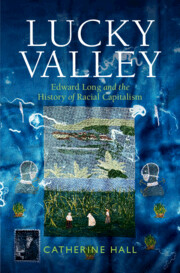Refine search
Actions for selected content:
57 results
The European Union’s Neighbourhood Policy and the Unacknowledged Mediterranean Color Line
-
- Journal:
- Journal of Race, Ethnicity and Politics , First View
- Published online by Cambridge University Press:
- 10 November 2025, pp. 1-22
-
- Article
- Export citation
Who is Disposable? The Making and Re-Making of the “Bad” Migrant at Europe’s Borders
-
- Journal:
- Journal of Race, Ethnicity and Politics , First View
- Published online by Cambridge University Press:
- 07 October 2025, pp. 1-22
-
- Article
-
- You have access
- Open access
- HTML
- Export citation
Six Pipelines: Invigorating Race in Canadian Political Science
-
- Journal:
- Canadian Journal of Political Science/Revue canadienne de science politique , First View
- Published online by Cambridge University Press:
- 25 September 2025, pp. 1-29
-
- Article
-
- You have access
- Open access
- HTML
- Export citation
Chapter 6 - Rethinking EU Social and Labour Law through Racial Capitalism
- from Part I - Law
-
-
- Book:
- Colonialism and the EU Legal Order
- Published online:
- 14 October 2025
- Print publication:
- 18 September 2025, pp 134-163
-
- Chapter
-
- You have access
- Open access
- HTML
- Export citation
Chapter 11 - Blackness and Value from the Harlem Renaissance to the Black Arts Movement
- from Part II - Histories
-
-
- Book:
- Money and American Literature
- Published online:
- 03 July 2025
- Print publication:
- 17 July 2025, pp 192-206
-
- Chapter
- Export citation
The World House Remodeled: Toward Beloved Community Through Housing Justice
-
- Journal:
- Journal of Law and Religion / Volume 39 / Issue 3 / September 2024
- Published online by Cambridge University Press:
- 04 July 2025, pp. 417-448
-
- Article
-
- You have access
- Open access
- HTML
- Export citation
Puntos de Encuentro: Exercising Active Forms of Citizenship in Buenaventura, Colombia
-
- Journal:
- Latin American Research Review ,
- Published online by Cambridge University Press:
- 02 July 2025, pp. 1-19
-
- Article
-
- You have access
- Open access
- HTML
- Export citation
From White Supremacy to a Multiracial Mainstream in Hawai‘i: How the Color Line Can Change
-
- Journal:
- Du Bois Review: Social Science Research on Race / Volume 22 / Issue 2 / Fall 2025
- Published online by Cambridge University Press:
- 16 May 2025, pp. 190-214
-
- Article
-
- You have access
- HTML
- Export citation
Those “who have no interest in the soil”: Poor Southern White People and Property in Antislavery Arguments for Homesteading
-
- Journal:
- Social Science History / Volume 49 / Issue 2 / Summer 2025
- Published online by Cambridge University Press:
- 28 May 2025, pp. 340-364
- Print publication:
- Summer 2025
-
- Article
-
- You have access
- Open access
- HTML
- Export citation
Chapter 18 - Rethinking Black Speculative Fiction
-
-
- Book:
- The New Nineteenth-Century American Literary Studies
- Published online:
- 02 January 2025
- Print publication:
- 23 January 2025, pp 265-280
-
- Chapter
- Export citation
3 - Rereading Omani Work History and Labour Market Governance
-
- Book:
- Millennial Dreams in Oil Economies
- Published online:
- 02 January 2025
- Print publication:
- 09 January 2025, pp 87-145
-
- Chapter
- Export citation
1 - The Moneychanger State
-
- Book:
- Money, Value, and the State
- Published online:
- 05 December 2024
- Print publication:
- 12 December 2024, pp 51-91
-
- Chapter
- Export citation
Racial Capitalism in an Ethnic Minority Border Region: Husbandry Development in Altay Prefecture, Xinjiang, China
-
- Journal:
- Du Bois Review: Social Science Research on Race / Volume 22 / Issue 1 / Spring 2025
- Published online by Cambridge University Press:
- 04 November 2024, pp. 118-137
-
- Article
-
- You have access
- Open access
- HTML
- Export citation
Anti-colonial raced capitalism in Malaysia: Contested logics, gendered repertoires
-
- Journal:
- Review of International Studies / Volume 51 / Issue 1 / January 2025
- Published online by Cambridge University Press:
- 25 October 2024, pp. 139-158
- Print publication:
- January 2025
-
- Article
-
- You have access
- Open access
- HTML
- Export citation
Introduction
-
- Book:
- Lucky Valley
- Published online:
- 11 January 2024
- Print publication:
- 22 February 2024, pp 1-38
-
- Chapter
- Export citation
10 - Words and Ropes: The Postwar Battles over Racial Order
- from Part III - Modern Traditions
-
- Book:
- Born in Blood
- Published online:
- 18 January 2024
- Print publication:
- 18 January 2024, pp 242-265
-
- Chapter
- Export citation

Lucky Valley
- Edward Long and the History of Racial Capitalism
-
- Published online:
- 11 January 2024
- Print publication:
- 22 February 2024
Introduction
-
- Book:
- Resisting Racial Capitalism
- Published online:
- 16 November 2023
- Print publication:
- 30 November 2023, pp 1-20
-
- Chapter
- Export citation
3 - War on Dirt
-
- Book:
- Resisting Racial Capitalism
- Published online:
- 16 November 2023
- Print publication:
- 30 November 2023, pp 59-80
-
- Chapter
- Export citation
6 - It Runs in the Family
-
- Book:
- Resisting Racial Capitalism
- Published online:
- 16 November 2023
- Print publication:
- 30 November 2023, pp 125-146
-
- Chapter
- Export citation
